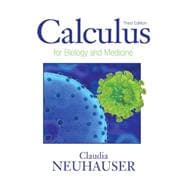For a two-semester or three-semester course in Calculus for Life Sciences.
Calculus for Biology and Medicine, Third Edition, addresses the needs of students in the biological sciences by showing them how to use calculus to analyze natural phenomena without compromising the rigorous presentation of the mathematics.
While the table of contents aligns well with a traditional calculus text, all the concepts are presented through biological and medical applications. The text provides students with the knowledge and skills necessary to analyze and interpret mathematical models of a diverse array of phenomena in the living world. Since this textbook is written for college freshmen, the examples were chosen so that no formal training in biology is needed.
This volume teaches calculus in the biology context without compromising the level of regular calculus. The material is organized in the standard way and explains how the different concepts are logically related. Each new concept is typically introduced with a biological example; the concept is then developed without the biological context and then the concept is tied into additional biological examples. The book features exceptionally detailed, step-by-step, worked-out examples and a variety of problems, including an unusually large number of word problems.
Preview and Review; Discrete Time Models, Sequences, and Difference Equations; Limits and Continuity; Differentiation; Applications of Differentiation; Integration; Integration Techniques and Computational Methods; Differential Equations; Linear Algebra and Analytic Geometry; Multivariable Calculus; Systems of Differential Equations; Probability and Statistics
For all readers interested in calculus for biology and medicine.









